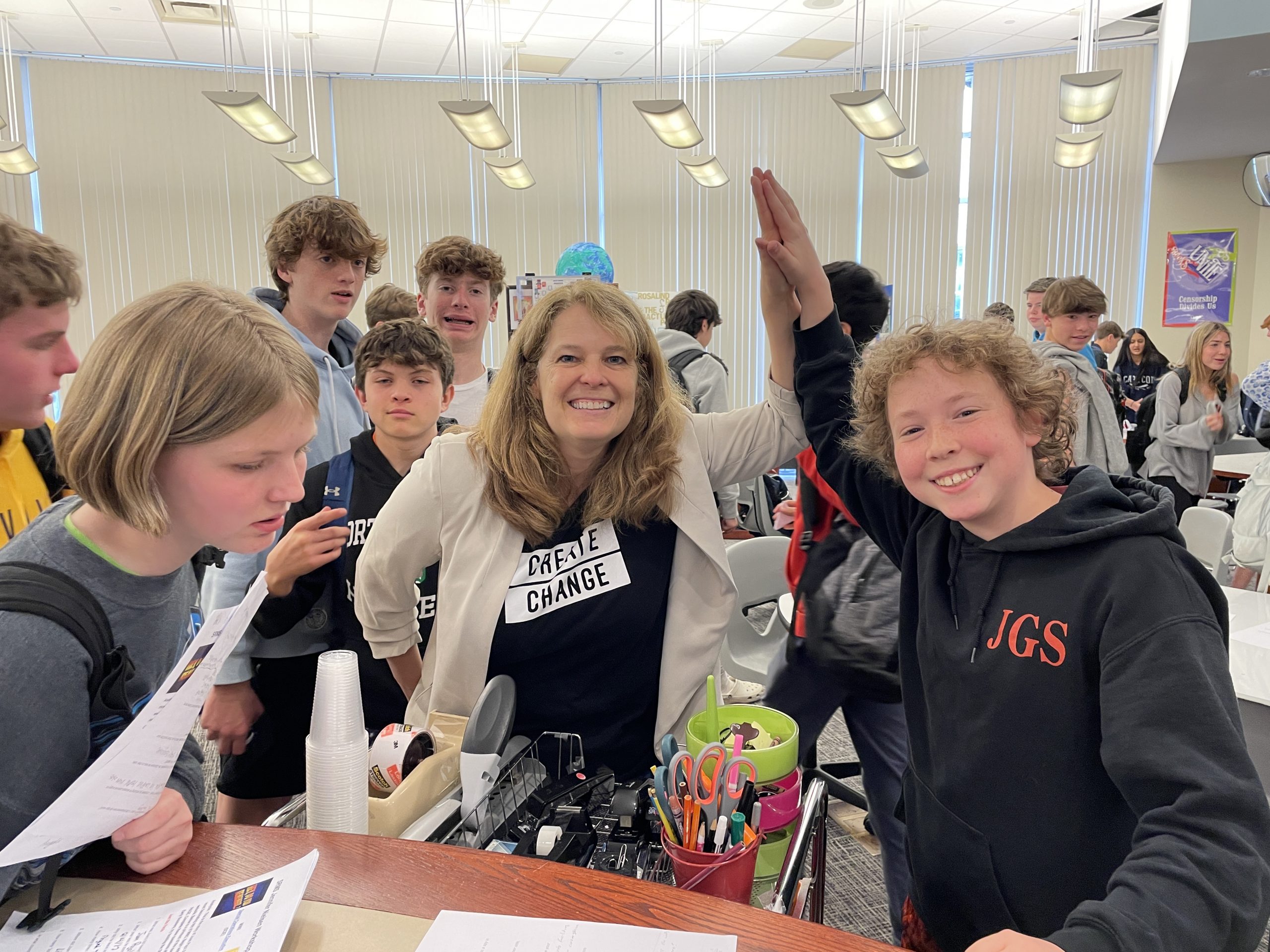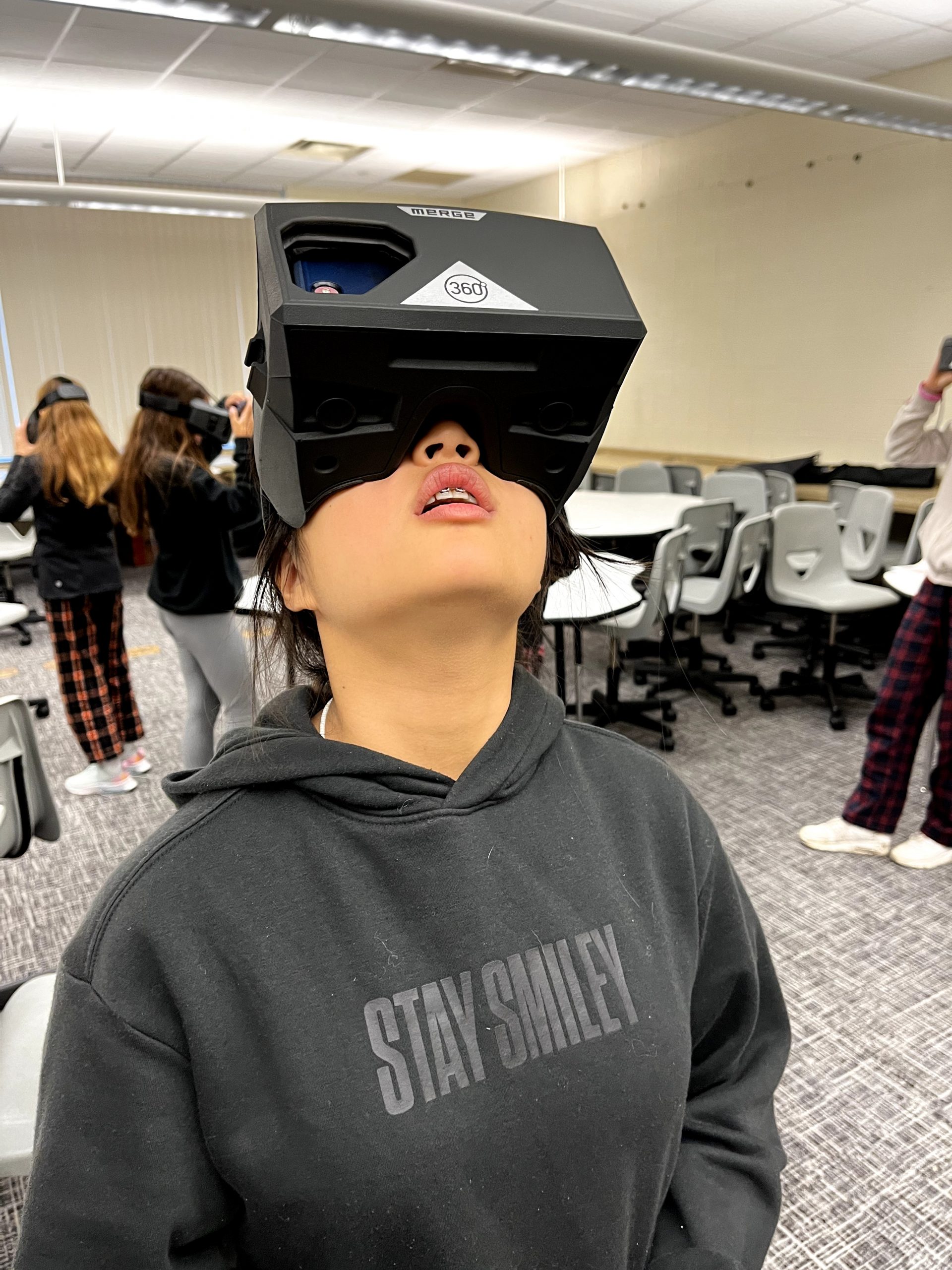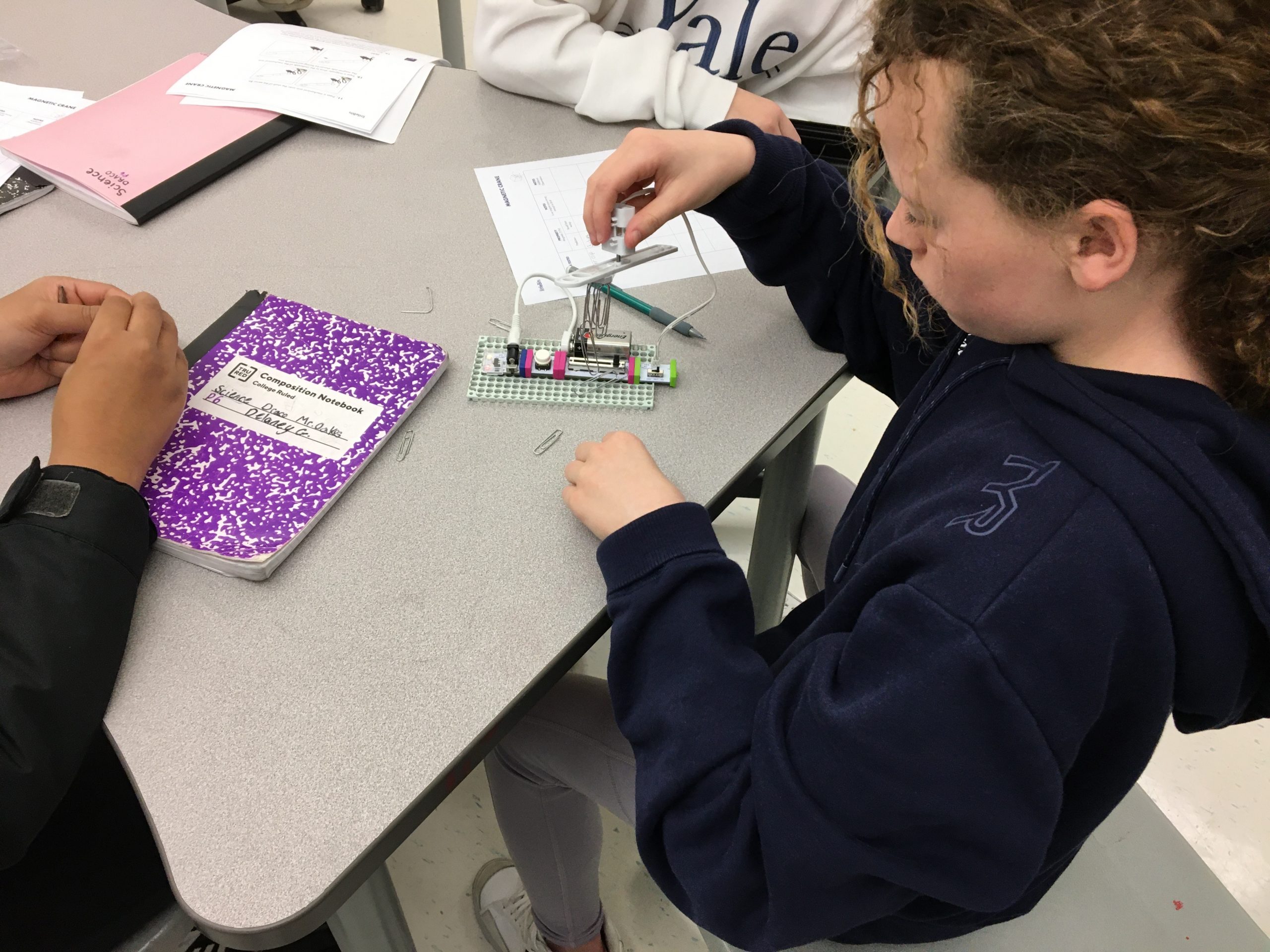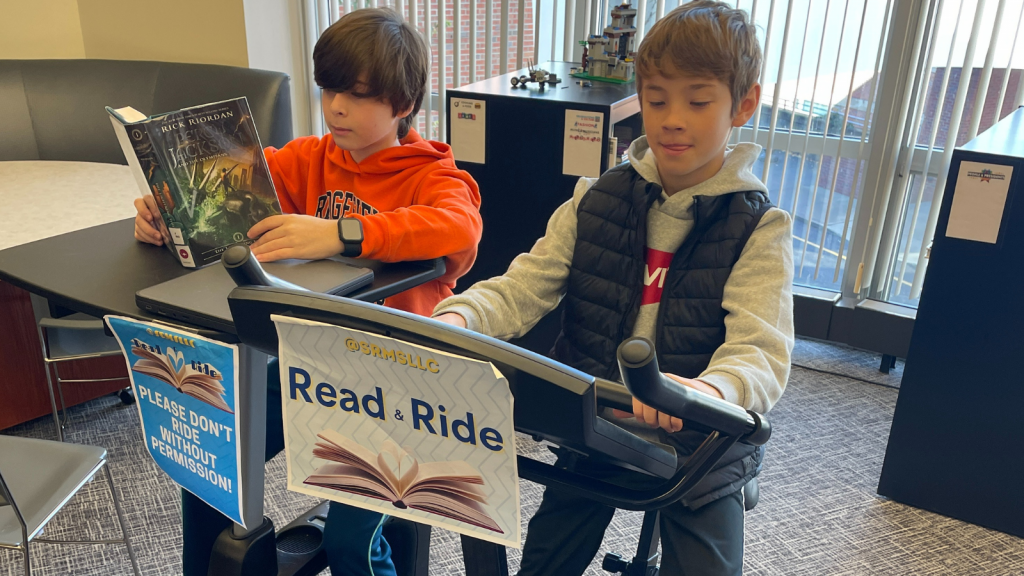The middle school library is an evolving space. What was once consistently a quiet space for reading has changed into a versatile space with a variety of functions, depending on the school. The Library Learning Commons at Scotts Ridge Middle School demonstrates how this evolution can create a library that serves as a hub of learning and innovation within the building. But it wasn’t always that way. A convergence of factors and intentional teamwork helped pave the way for our success. Our story is one of teamwork, collaboration and creativity, and community connections.
A Winning Combination
The turnover of our library media staff nine years ago coincided with the growing movement away from traditionally quiet school library ‘repositories’ to today’s vibrant Library Learning Commons (LLC) framework. We recruited a long-time technology paraprofessional to partner alongside our new library media specialist. Their teamwork has proven to be a winning combination as they have fostered a collaborative spirit within our school and transformed our LLC into a truly innovative space.
I, Tim, and my assistant principal arrived at Scotts Ridge a few years before this transition from a neighboring district. We envisioned a creative, collaborative, and engaging learning environment supported by our Fail Forward attitude toward healthy and productive risk-taking. Mundane announcements would shift to email communication. We wanted our library media specialist to present at staff meetings, provide professional development, attend conferences, and expand learning wherever possible. We envisioned them working alongside our library paraprofessional and technology integrator as a program administrator and leader, two of the most important criteria in AASL’s Position Statement: Definition of an Effective School Library (American Association of School Librarians, 2018.)
A few years after hiring new library staff, our district became a Google for Education district and our middle schools went 1:1 with Chromebooks for every student. This required professional development and support for staff and students transitioning to a powerful but entirely different learning management model, as well as updates on available programs to help facilitate the adaptation. Our LLC team played a vital role in this shift.

Nurturing Creativity and Collaboration
By sharing examples of creative collaborations at staff meetings and encouraging experimentation, partnerships between our LLC leaders and teachers have led to remarkable opportunities for students to connect concepts in unique and exciting learning outside the classroom. A recent example includes a 7th-grade Social Studies unit tied to the Cold War. Beginning with a first-chapter read-aloud of Jennifer Nielsen’s historical fiction novel, A Night Divided, the unit tied together research, game-based assessments, and personalized interpretations of the story with student creations of soundtracks to accompany the book. The author was looped into activities via the power of social media, and the project culminated with a live visit by Jennifer Nielsen, thanks to an education foundation grant.

Another recent example transformed a traditional 6th-grade math lesson into a humanitarian relief effort utilizing small robots. Imagine supplanting graph paper and rulers with a computer-enhanced Sphero robot where students plot graphs using an app and must provide life-saving supply drops with the accuracy of their plotted course. If off course, relief supplies for South Sudan would end up in the water!
These partnerships have grown dramatically over the years. Our faculty is fully engaged at meetings when our LLC and teacher teams make presentations on the projects they’ve undertaken. Our teachers summarily underscore the importance of this teamed approach by sharing experiences broadly. This model has manifested in a schoolwide synergy dedicated to creating exciting and authentic learning experiences for our students.
Community Connections
Reading can be an engaging entry point for powerful community connections. Our journey in this area began in the fall of 2020 with an email invitation from our library media staff: “Anti-racism begins with action: Join us in a community read-aloud of two titles representing marginalized communities: Prairie Lotus by Linda Sue Park and Stamped: Racism, Anti-Racism and You by Jason Reynolds and Ibram X. Kendi.” This work was shared with the Connecticut Association of Schools (CAS) in a webinar to promote and share important action steps centered on the topics of antiracism, inequality, and social justice.
As a result of these discussions, we created a structure to ensure that dynamic and authentic dialogue around the aforementioned topics endures. For the third consecutive year now, we are bringing our students together for powerful conversations with a neighboring district, centered around a book. Our “One Book, Two Schools” initiative features in-school book discussions once a month, virtual discussions with our partner schools a few times a year, and in-person visits to one another’s schools at the end of the year. Middle schoolers from diverse districts are learning, growing, and getting vulnerable together, ultimately discovering how alike and connected they are through the power of words.
Looking Ahead
It is important to encourage your library media specialist to take on leadership opportunities. Ours leads “One Book, Two Schools” and is also an advisor of our “No Place for Hate” Club, an Anti-Defamation League initiative designed to reduce incidents of bias and bullying. Scotts Ridge is one of only seventeen schools in Connecticut to receive the “No Place for Hate” designation. Going forward, we would like to see the number of students participating in these two groups continue to grow.
Additional goals include:
- Increase and widen opportunities to bring engaging and mobile opportunities and resources into the classrooms, adding ‘spokes’ to the ‘hub.’
- Grow the number of creative and collaborative assured experiences that occur each year, ensuring that all students participate in engaging lessons that address standards.
- Widen funding avenues to bump author visits from periodic to annual.
- Increase opportunities for engaging, research-based activities employing next-level AR and VR resources, a growth step from our early adaptation.
- Increase understanding in our community and beyond as to the power of fully-funded and certified school libraries.
Beyond our School Community
As a member of the American Association of School Librarians (AASL) School Leader Collaborative, I have the pleasure of working alongside superintendents and principals from throughout the country who were nominated by their school librarians for their active and energetic support of fully funded and staffed school libraries. I am honored to be a part of this five-person cohort and humbled by their work. As a part of our two-year tenure, we are subscribed to the AASL listserv, where school librarians from throughout the country seek and offer help, advice, tips, and resources to fellow colleagues. In thirty years of education, I have never come across a more connected and caring collection of professionals who share their work so freely.


One of our goals as members of the Collaborative is to reach decision-makers beyond the school community, including those who make budgetary decisions. Years of research confirm that the presence of certified librarians in fully funded libraries correlates to improved student outcomes. Reports such as The Secret to Better Literacy Scores Starts with School Librarians lead us to a downloadable study titled, “Could School Librarians be the Secret to Increasing Literacy Scores?” (EveryLibrary.) This report cites direct connections between reading and writing scores and the presence of school librarians, naming states that have passed legislation protecting the presence of certified school librarians.
Data can be powerfully convincing to decision-makers, especially with regard to math and reading. However, well-staffed and funded school libraries also provide a nurturing and “safe space” that supports the whole child. Unfortunately, economically disadvantaged communities are at a greater risk of losing their librarian. Citing a 2018 Education Week study, Forbes reported, “The nation’s collective failure to rebuild its public information infrastructure is hitting minorities the hardest.” (Rowe, 2018.) The Education Week study cites, “Districts which have not lost a librarian since 2005 are 75 percent white, while the 20 districts that have lost the most librarians had on average 78 percent minority student populations” (Sparks and Harwin, 2018.) Our collective responsibility is to draw attention to this disparity, especially in this era of book banning and direct attacks against educators.
Do Now’s/Parting Thoughts
In a March School Library Journal article regarding school libraries and how to reach administrators, 2023 School Librarian of the Year Julie Stivers suggests sharing stories, which is “‘a kind of data’ that registers with administrators” (Bauld, 2023.) Recent research speaks to the importance of creating “new knowledge about the library and librarian’s role,” helping principals create a vision in order to “build a shared understanding of student learning outcomes” (Ellis, 2022.)
Our recommendation: Don’t wait for your librarian to share stories; ask him or her! Get familiar with the space. Visit with students and staff periodically throughout the day. Study the AASL Standards and Crosswalks, which mesh naturally with so many other core disciplines (American Association of School Librarians.) Invite your librarian to present at staff meetings (even if it’s out of their comfort zone.) Pay attention to the research linking student outcomes to fully funded and staffed school libraries. Help them tell the stories in your community.
Keys to making your LLC the learning hub of your school:
- Have your LLC leader share opportunities for innovation at faculty meetings
- Encourage joint adventures between classroom teachers & LLC leaders – share results!
- Support the LLC budget where possible; trust your library program leader
- Support innovative ideas for the physical space, such as “Collaboration Station” TV screens, Read and Ride bicycles, nesting and mobile workstations for the makerspace, technology tools that deepen learning. Innovation draws people in, both staff & students!
- Consider a genre-based system for your LLC to allure students more quickly and easily to books they will enjoy, empowering their independence. Listen to how they discuss books with peers while “shopping” for their next read
- Use displays to engage students and prompt conversations
- Invite Faculty into the space – often!
- Support ideas and risk-taking
- Adopt a Fail Forward mentality; after all, making mistakes is how we learn, grow, and become better!
Our school librarian’s recommendations for reaching teachers and influencing outcomes:
- Staff meeting presentations with teachers (“snowball effect”)
- “Science (or Math/SS/ELA) in the Sandbox” events in the LLC – teacher experimentation tied to curriculum
- Scour the curriculum/toss out ideas
- Understand the #AASLstandards and #ISTEstandards
- Follow school library leaders and hashtags on social media (@AASL, #TLchat, @istelib, @FutureReady, @joycevalenza, @shannonmmiller, SLJ School Librarian of the Year winners, etc.)
- Get connected with your state school librarian association and AASL
- Be brave – if teachers don’t have time to meet, try hallway planning (hey, whatever it takes!)
- Ask to pop in (w brevity) to department, team, and grade-level counterpart meetings. Get admin support for this.
- Reach your community both inside and outside of the building through social media and PTA newsletter posts
- Train Student Ambassadors and parent volunteers
- If approached with an idea or interest by a teacher, never say no!
- Think like a scientist.
- Question your own beliefs.
Tim Salem was a social studies teacher for 10 years before becoming an administrator at nearby Danbury High School, Tim Salem has been principal of Scotts Ridge Middle School in Ridgefield, CT since 2010 and has worked in education for 30 years. Tim is the recipient of The CAS (CT Assoc. Of Schools) Assistant Principal of the Year Award, The CAS Mahatma Gandhi-Martin Luther King, Jr. Peace Award, The Anne Frank USA Outstanding Educator Award, The CT School Counselor Association Principal of the Year Award, The Connecticut Association of School Librarians’ 2020 Administrator’s Award, The 2022 AASL Distinguished School Administrator Award, and most recently was named to the 2022-24 AASL School Leader Collaborative.
Janine Johnson brings her marketing background to the advocacy and relationship-building so central to library media work today. Now in her tenth year teaching and ninth at Scotts Ridge Middle School, Janine loves the space that the middle school framework allows for creative collaboration. In 2018 her team earned the AASL Collaborative School Library Award and that same year she was awarded the CASL Carlton W.H. Erikson Award. Janine nominated Tim for the two AASL recognitions he recently garnered (2022 AASL Distinguished School Administrator Award, 2022-24 AASL School Leader Collaborative.) Janine has published articles in a variety of trade publications and is a member of the board of the Connecticut Association of School Librarians as well as a 2020 Fund for Teachers Fellow.
References
- American Association of School Librarians. AASL Standards Framework for Learners. 2018,
- American Association of School Librarians. Definition of an Effective School Library. 11 Nov. 2018,
- American Association of School Librarians. Standards Crosswalks. Accessed 17 Nov. 2023.
- Bauld, Andrew. “Julie Stivers: Creating a Place to Read and Thrive | 2023 School Librarian of the Year.” School Library Journal, 20 Mar. 2023.
- Ellis, Deeth. “The Principals’ Knowledge and perception of the role of the School Librarian.” MSLA Forum, 17 May 2022. .
- “The Secret to Better Literacy Scores Starts with School Librarians.” Accessed 20 Nov. 2023.
- Rowe, Adam. “S. Public Schools Have Lost Nearly 20% Of Their Librarians Since 2000.” Forbes, 21 May 2018.
- Sparks, Sarah D., and Alex Harwin. “Schools See Steep Drop in Librarians, New Analysis Finds.” Education Week, 25 May 2018.
